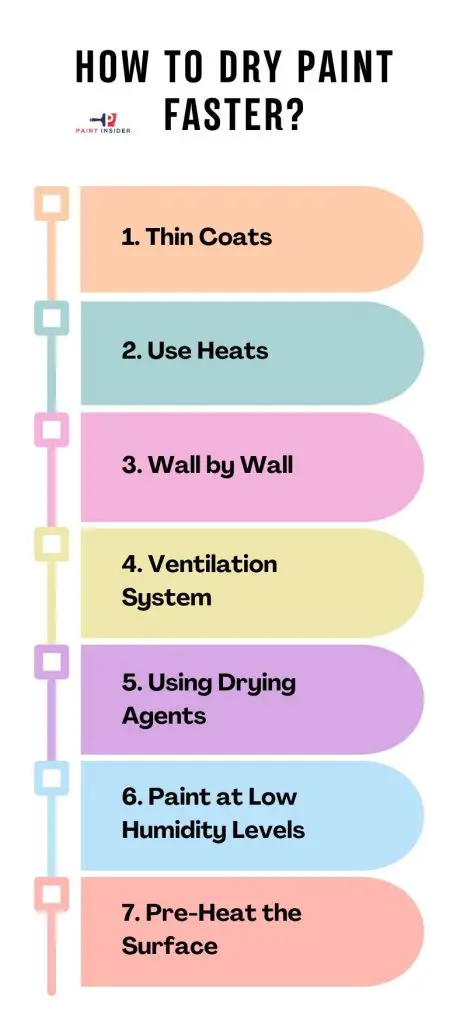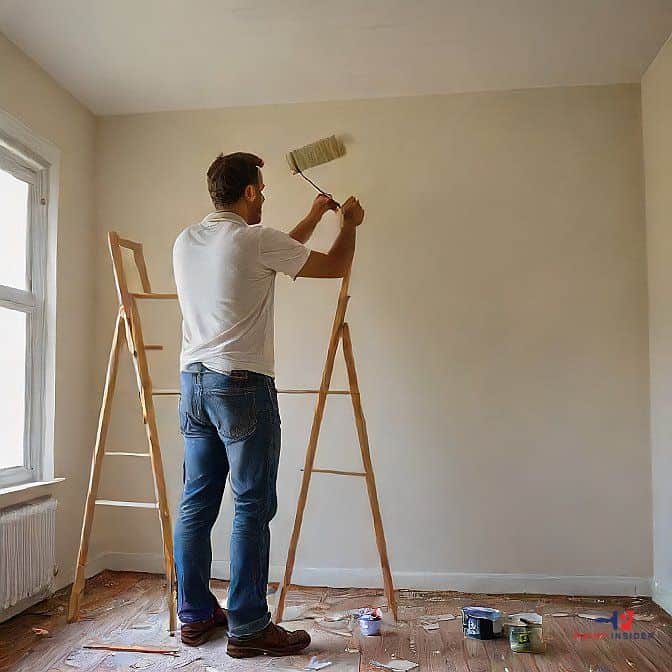Drying paints and curing paints are two different important parts of the painting. This article is a complete guide about how to dry paint fast.
Are you planning to spruce up your room? Changing wall paint is one of the fantastic ways to transform your room. Paint is an important and easiest job in renovation projects, and it is budget-friendly too if you are doing it yourself. But you need to follow some pro tips to get perfect results without any professional help and don’t want to turn this project into a nightmare.
Introduction: The Need for Fast-Drying Paint
In today’s fast-paced world, the demand for efficiency permeates every aspect of our lives, even in painting projects. Whether you’re a DIY enthusiast or a professional painter, the need to minimize downtime is essential. Fast-drying paint not only speeds up project completion but also allows for quicker corrections and layers, ultimately resulting in a polished finish without sacrificing quality. Imagine starting your next creative endeavor and being able to apply multiple coats within hours instead of days. This can transform your workflow significantly.
Moreover, environmental factors such as humidity and temperature fluctuations can complicate traditional drying processes. Fast-drying paint mitigates these issues by adapting to varying conditions, giving you more flexibility regardless of when inspiration strikes. Additionally, with advancements in technology and formulation, modern paints are designed to provide excellent adhesion and durability while maintaining quick-drying properties. By mastering techniques on how to dry paint fast, you empower yourself not only to create more efficiently but also to experiment more freely breathing life into your artistic visions without unnecessary delays.
Understanding the Paint-drying process
The paint drying process comprises evaporating the solvents from your paint coating, leaving your paint dry to the touch. Paints are made of pigments, binders, solvents, and additives.
Over the past decade, the market has been crammed with a huge range of paints. Each type of paint takes a different amount of time and techniques to dry faster. So what method you use to dry your paint faster depends on the type of paint that you can use for this job. First, we will go through the types of paints and their characteristics to give you a better understanding.
Enamel or Oil-Based Paints
Oil-based paints are thicker and have a high level of volatile organic compounds, and take more time to dry. It can take up to 24 hours to completely dry, and you have to wait overnight to apply the second coat.
Water-Based Paints
Water-based paints have a low level of toxic chemicals and are prone to fast drying (can take just 4 hours). These paints are easier to use. Latex and acrylic paints are the two main types of water-based paints. Whatever paint you are using, it sometimes becomes difficult to wait to apply the second coat, and there is nothing more boring than waiting. If you want to move faster to get this job done, here are some easy tips and tricks on how to dry paint faster!
How To Dry Paint Faster?
In the following article, we will focus on professional tips that will help to dry paint faster. This article will exhibit only the paint-drying process.

Thin Coats
Apply thin coats! The less paint on the surface, the faster it will dry. Most people apply as much paint as they want at once; abstain from doing that. Multiple coats work better than one thick coat. A thin coat tends to dry faster, and you don’t have to wait longer to apply the second coat.
Use Heats
You can also opt to use heat sources. It is the most useful method during cold weather. You can use:
- Heat Guns
- Hair Dryers
- Space Heaters
But make sure you do not overheat the area as, in most cases, it can cause cracks, especially when using paints with a crack finish as it could widen the cracks.
Wall by Wall
Go for this amazing technique of painting one wall at a time for the first coat. Then go for another wall while the coat of the first wall dries. Always try to finish applying the first coat to all the walls, so that your first wall is ready for the second coat.
Ventilation System
Make sure to have a good air circulation system in your area. It will speed up the drying process. Do not close the doors and windows during and after painting to keep the air moving. You can also keep room fans running so that fumes from the paint can escape.
Using Drying Agents
There are many special agents available in the market. These drying agents are really helpful for drying paints, especially oil paints or enamel paints. These agents are useful between coasts of finish, even in damp or cool weather, and reduce drying time between multiple coats. Most people use these products with varnishes, oil-based paints, and drying puffy paints. Some of these drying agents are:
- Linseed Oil
- Cobalt
- Turpentine(Thinner)
Paint at Low Humidity Levels
Suppose the atmosphere has a low humidity level. In that case, your paint dries quickly as humidity will delay the drying process, so if you have a dehumidifier or air conditioner in your room, turn it on. If you are painting an outside wall of your house, choose the least humid day to paint your wall.
Pre-Heat the Surface
Pre-heat or increase the temperature of the surface before applying the first coat of paint. But be careful not to make it too hot; keep it warm. This trick will surely pace up the drying process. It is mostly applicable to smaller areas like furniture.
How To Dry Puffy Paints Faster?
Are you planning some paint crafts on your furniture and worried about how to dry puffy paints faster? Puffy paints allow you to create craft designs on different surfaces, including furniture, fabrics, and paper. It usually takes 15 to 30 minutes to dry, depending on the amount of paint you have used. There are many methods on how to dry puffy paint faster, but be careful; it can be dry outside and still be wet from inside, so make sure to work a little bit more.
- Take out the painted item outdoors and keep it under sunlight.
- Heat guns or heat dryers, this method is best to set dry the puffy craft paint.
Final Thoughts
Not just the walls, you can also use paint to brighten up your old furniture. Consider sanding down a tired dresser or nightstand and painting it a bright, fun color. Some new hardware and you’ll have a brand new piece of furniture in your room! How to make paints dry faster depends on the type of paint you’re using and the surface being worked on. We have explored which paint dries faster and which one needs the involvement of drying agents for professional-like results.

However, paints vary in their characteristics, and there are some special techniques to fasten the drying process. It is best to choose one with a quick-drying ability on any surface wall, furniture, canvas, or fabric. The other factors involved in making paints dry faster are air freely circulating in the area (ventilation), heat sources, and lower humidity levels.
Now you have become a pro by learning these useful tips, and we hope that it has made your home improvement project easier.
Common Mistakes to Avoid When Drying
One of the most common mistakes when drying paint fast is applying thick layers, which can significantly prolong drying time. Instead, opt for thin coats, they not only dry more quickly but also improve the overall finish by minimizing drips and runs. Another vital tip is overlooking environmental factors such as temperature and humidity. Painting in a humid environment can lead to prolonged drying times, so consider using fans or dehumidifiers to create an optimal space for your project.
Another pitfall involves rushing the process by forcing accelerated drying methods like using heat guns or hair dryers, which might seem effective but can cause uneven surfaces or even bubbling if not handled carefully. A better approach might be to choose quick-drying paints formulated specifically for speed without sacrificing quality. Don’t forget about ventilation ensuring good air circulation can enhance evaporation rates, speeding up the entire drying process while avoiding that suffocating paint fume dilemma. By sidestepping these common errors, you’ll master how to dry paint fast without compromising on quality!
Conclusion: Mastering Fast-Paint Techniques
In conclusion, mastering fast-paint techniques can significantly enhance both your creativity and productivity as an artist. Learning how to dry paint fast not only allows you to layer colors more efficiently but also enables you to experiment fearlessly without the dreaded waiting time. Innovative drying methods, such as using a hairdryer on a low setting or investing in items like quick-dry mediums open new avenues for blending and creating textures seamlessly.
Embracing these techniques encourages spontaneity in your work, pushing boundaries that often lead to unexpected masterpieces. Consider developing a routine that incorporates swift painting practices, which can transform even the most meticulous projects into dynamic expressions of art. In this fast-paced world, adapting your skills will ignite your passion and elevate your artistic journey turning what once required hours into exciting creations made in mere moments. So grab those brushes and let the magic of speed inspire you!

